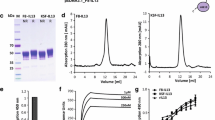Abstract
Recombinant interleukin-2 (rIL-2) therapy has been shown to be of value in the treatment of some cases of melanoma and renal cell carcinoma. However, its use can be limited by severe systemic toxicity. Targeting rIL-2 to the tumor should improve the antitumor immune response and decrease the systemic toxicity. With this aim, we have employed recombinant DNA techniques to construct a single-chain antibody interleukin-2 fusion protein (SCA-IL-2).
The protein used in this model system consists of the variable domains of the antilysozyme antibody D1.3 fused to human IL-2 and is expressed inE. coli. It retains antigen-binding specificity and has the full biological activity of rIL-2.
This approach can be taken to generate SCA-IL-2 proteins that bind to appropriate cellular antigens. In vivo administration of tumor-binding SCA-IL-2 should result in a localized high concentration of rIL-2 in the tumor tissues, maximizing the antitumor response while keeping systemic side effects to a minimum.
Similar content being viewed by others
Abbreviations
- rIL-2:
-
recombinant interleukin-2
- SCA:
-
single-chain antibody
- SCA-IL-2:
-
single-chain antibody interleukin-2 fusion protein
References
Gillis, S., Ferm, M. M., Ou, W., and Smith, K. A. (1978) T cell growth factor: parameters of production and a quantitative microassay for activity.J. Immunol. 120, 2027–2032.
Rosenberg, S. A., Lotze, M. T., Yang, J. C., Aebersold, P. M., Linehan, W. M., Seipp, C. A., and White, D. E. (1989) Experience with the use of high dose interleukin-2 in the treatment of 652 cancer patients.Ann. Surg. 210, 474–485.
Fearon, E. R., Pardoll, D. M., Itaya, T., Golumbek, P., Levitsky, H. I., Simons, J. W., Karasuyama, H., Vogelstein, B., and Frost, P. (1990) Interleukin-2 production by tumor cells bypasses T helper function in the generation of an antitumor response.Cell 60, 397–403.
Williams, D. P., Parker, K., Bacha, P., Bishai, W., Borowski, M., Gebauffe, F., Strom, T. B., and Murphy, J. R. (1987) Diptheria toxin receptor binding domain substitution with interleukin-2: genetic construction and properties of a diptheria toxin-related interleukin-2 fusion protein.Prot. Engin. 1, 493–498.
Kiyokawa, T., Williams, D. P., Snider, C. E., Strom, T. B., and Murphy J. R. (1991) Protein engineering of diptheria-toxin-related interleukin-2 fusion toxins to increase cytotoxic potency for high affinity IL-2-receptor bearing target cells.Prot. Engin. 4, 463–468.
Lorderboum-Galski, H., Fitzgerald, D., Chaudary, V., Aldhaya, S., and Pastan, I. (1988) Cytotoxic activity of an interleukin-2-Pseudomonas exotoxin chimeric protein produced inEscherichia coli.Proc. Natl. Acad. Sci. USA 85, 1922–1926.
Landolf, N. F. (1991) A chimeric IL-2/Ig molecule possesses the functional activity of both proteins.J. Immunol. 146, 915–919.
Fell, H. P., Gayle, M. A., Grosmaire, L., and Ledbetter, J. A. (1991) Genetic construction and characterization of a fusion protein consisting of a chimeric F(ab’) with specificity for carcinomas and human IL-2.J. Immunol. 146, 2446–2452.
Houston, J. S., Levinson D., Mudgett-Hunter, M., Tai, M.-S., Novotny, J., Margolies, M. N., Ridge, R. J., Bruccoleri, R. E., Haber, E., Crea, R., and Opperman, H. (1988) Protein engineering of antibody binding sites: recovery of specific activity in an anti-digoxin single-chain Fv anlogue produced inEscherichia coli.Proc. Natl. Acad. Sci. USA 85, 5879–5883.
Colcher, D., Bird, R., Roselli, M., Hardman, K. D., Johnson, S., Pope, S., Dodd, S., Pantoliano, M. W., Milenic, D. E., and Schlom, J. (1990) In vivo tumor targeting of a recombinant single-chain antigen-binding protein.JNCI 82, 1191–1197.
Clackson, T., Hoogenboom, H. R., Griffiths, A. D., and Winter, G. (1991) Making antibody fragments using phage display libraries.Nature 352, 624–628.
Marks, J. D., Hoogenboom, H. R., Bonnert, T. P., McCafferty, J., Griffith, D., and Winter, G. (1991) By-passing immunization. Human antibodies from V-gene libraries displayed on phage.J. Mol. Biol. 222, 581–597.
McCafferty, J., Griffiths, A. D., Winter, G., and Chiswell, D. J. (1990) Phage antibodies: filamentous phage displaying antibody variable domains.Nature 348, 552–554.
Stauch, K. L., Johnson, K., and Beckwith, J. (1989) Characterization of degP; a gene required for proteolysis in the cell envelope and essential for growth ofEscherichia coli at high temperature,J. Bact. 171, 2689–2696.
Ward, E. S., Gussow, D., Griffiths, A. D., Jones, P. T., and Winter, G. (1989) Binding activities of a repertoire of single immunoglobulin variable domains secreted fromEscherichia coli.Nature 341, 544–546.
Smith, K. A., Favata, M. F., and Oroszlan, S. (1983) Production and characterization of monoclonal antibodies to human interleukin 2: strategy and tactics.J. Immunol. 131, 1808–1815.
Laemmli, U. K. (1970) Cleavage of structural proteins during the assembly of the head of bacteriophage T4.Nature 227, 680–685.
Towbin, H., Staehelin, T., and Gordon, J. (1979) Electrophoretic transfer of proteins from polyacrylamide gels to nitrocellulose sheets; procedure and some applications.Proc. Natl. Acad. Sci. USA 76, 4350–4354.
Gillis, S. and Smith, K. A. (1977) Long term culture of tumour-specific cytotoxic T cells.Nature 268, 154–156.
Lei, S. P., Lin, H. C., Wang S. S., Callaway, J., and Wilcox, G. (1987) Characterization of the Erwinia carotova pelB gene and its product pectate lyase.J. Bact. 169, 4379–4383.
Savage, P. M., Beynon, H. C., Hartourian, R., Walport, M. J., and Epenetos, A. A. (1992) A single chain antibody interleukin-2 fusion protein mimics the effects of rIL-2 on endothelial cell permeability, inCell Adhesion Molecules in Cancer and Inflammation (Epenetos, A. A., ed.), Chapman and Hall, London.
Lotze, M. T., Chang, A. G., Seipp, C. A., Simpson, C., Vetto, J. T., and Rosenberg, S. A. (1986) High dose recombinant interleukin-2 in the treatment of patients with disseminated cancer.JAMA 256, 3117–3124.
LeBerthon, B., Khawli, L. A., Alauddin, M., Miller, G. K., Charak, B. S., Mazumder, A., and Epstein, A. L. (1991) Enhanced tumor uptake of macromolecules induced by a novel vasoactive interleukin-2 immunoconjugate.Cancer Res. 51, 2694–2698.
Hennigan, T. W., Begent, R. H. J., and Allen-Mersh, T. G. (1991) Histamine, leukotriene C4 and interleukin-2 increase antibody uptake into a human carcinoma xenograft model.Br. J. Cancer 64, 872–874.
Author information
Authors and Affiliations
Rights and permissions
About this article
Cite this article
Savage, P., So, A., Spooner, R.A. et al. A recombinant single-chain antibody interleukin-2 fusion protein. Cell Biophysics 22, 61–77 (1993). https://doi.org/10.1007/BF03033867
Issue Date:
DOI: https://doi.org/10.1007/BF03033867




